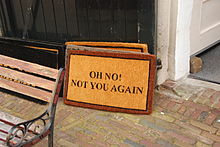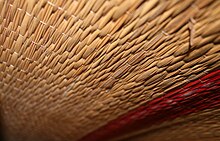Mat
This article has multiple issues. Please help improve it or discuss these issues on the talk page. (Learn how and when to remove these template messages)
|

A mat is a hard floor covering that generally is placed on a floor or other flat surface. Mats serve a range of purposes including:
- serving to clean items passed over it, such as a doormat, which removes dirt from the soles of shoes
- protecting that which is above the mat, such as a wrestling or gymnastics mat, or an anti-vibration mat
- protecting that which is beneath the mat, such as a place mat or the mattingused in archival framing and preservation of documents and paintings
- providing a regular or flat surface, such as a cushioned computer mousepad
Types

In domestic settings
- In homes or rooms where people sit predominantly on the floor (common in Japan, Korea, India, and formerly China), mats may cover entire rooms, or be used in certain areas for sitting or sleeping. The traditional Japanese style of mat is known as the tatami. Shoes are typically removed before entering these areas to keep out dirt and debris.
- A doormat or door-matshoes before entering. Doormats are usually made from tough, long-lasting material such as coir, palmyra (palm) fibres and stalks, nylon, rubber, cloth, or aluminium and other metals. A doormat may also be known as a welcome mat, as its location at an entrance constitutes a "welcome" to visitors, and may therefore also bear some word, message or sign of greeting. The lowly purpose for which doormats exist has also led to informal use of the term as a reference to people who behave timidly or passively when exploited by others[citation needed] (see also Caspar Milquetoast).
- A cabinet mat is a mat made of rubberthat protects kitchen cabinets, more particularly kitchen sink base cabinets, from leaks, water damage, mold and household item spills that commonly occur in the kitchen sink cabinet.
- A bath mat is used on the floor of a bathroom to provide a warm non-slip surface, and to absorb small amounts of water, much like a towel.

Tapis de Bain design - A place mat or serving mat is a flat piece of fabric or other type of material used on a table at the points at which dishes and plates will be located during a meal. One of the common purposes of such mats is to provide a thermal and physical barrier between that which is placed on the table, and the table itself—for instance, to stop hot objects from marring the finish.
Car mats
A
Anti-fatigue mats
"Anti-fatigue mats" are designed to help a person who is working in a standing position for prolonged periods of time. Most anti-fatigue matting is a combination of an ergonomic pattern and a cushioning underlay. The cushioning causes constant subconscious balance checks and micro movements that stimulate blood flow through the legs and lower extremities. This results in better circulation and less fatigue. The cushioning underlay insulates the feet from the hard surface, cold floors, vibrations, moisture and sound.[2] Their unique design encourages the user to make continual micro-movements[3] which provides a wealth of health benefits, such as minimizing back pain, foot pain, weariness, stress, etc. Anti-fatigue mats are one of the approaches to prevent injuries, caused by working in a standing position. In a study at the Center of Ergonomics at the University of Michigan in 1987, ergonomist Mark Redfern concluded that different standing surfaces can have dramatic effects on physical fatigue. Workers who stood on anti-fatigue mats were able to reduce the level of fatigue and discomfort by as much as 50%.[4] This type of mat is recommended by Occupational Safety and Health Administration. The range of common materials for manufacturing anti-fatigue mats includes vinyl, wood, PVC tubing, rubber, PVC closed cell foam, polypropylene, nitrile rubber. Anti-fatigue mats were initially used in factories and production lines where staff has to stand for the majority of their working shifts.
Anti-fatigue mats come in various types and materials for industrial or commercial applications for a variety of workplace conditions that exist as well as the variety of workplace designs from individual work benches, to large assembly lines or complex manufacturing work stations. Work place environments can vary from dry areas to wet or extremely oily areas. Plus specialized industries may need additional properties such as fire retardant matting for welding, static dissipative matting for electrostatic discharge (ESD) protection, anti-microbial for food industry applications.[2]
Today, this type of ergonomic mat is commonly used during trade shows for floor covering, in hospitals and clinics during surgeries to cover the floor near surgical tables to minimize surgeons fatigue resulted from continuous standing. Also these mats are used in housekeeping, especially for kitchen floors to alleviate fatigue during cooking.
Cleanroom mats
The purpose of a
An alternative clean room mat is one made from polymeric material. Polymeric products are made from a blend of pure polymeric compounds and have a three- to five-year life cycle. When a polymeric surface becomes dirty, operators can clean it with a sponge and a mop with detergent and dry the surface with a sqee. This quick cleaning process can be incorporated into the facility's regular wet-clean cycle.[5]
The mats differ by composition:
- One-piece mats are usually used on the permanent basis. One-piece mats can be handcrafted or factory-made. The standard shapes of one-piece mat are rectangular, square, round and elliptic. One-piece mats are produced in the huge variety of sizes and colors. Real and synthetic materials are used for one-piece mats production.
- Linear length mats are manufactured as rolls that can extend 20 meters up to 40 meters for long production lines, assembly lines and packing lines. Mats are manufactured in standard lengths or factory-made to custom sizes.
- Modular mats, also well known as interlocking tiles or interlocking floor mats, are manufactured using the “jigsaw puzzle” structure. Unlike one-piece mats, modular mats consist of numerous elements that are easily and seamlessly assembled. Compared to other types of mats, interlocking mats come in several sizes, depending on the number of pieces in one kit. Modular mats are a good solution for non-rectangular areas where standard shape mats are useless. Interlocking mats are commonly used on a one-time or temporary basis: fitness centres and sport competitions, trade shows and conferences. Modular mats require less place for storage and can be easily transported.
Rubber grass mats
Rubber grass mats are used commonly for around play equipment on playgrounds, schools and domestic properties where there is a risk of falling. As one of the most common and simple methods of protecting against a critical fall from height, rubber grass mats are usually simply laid on a grass or soil surface and immediately offer protection against serious harm.[6] Usually made from a virgin rubber material and a featuring a design which is around 90% open cell, the mats allow for grass to grow within the structure, offering a green and free draining solution to improving safety in play areas and playgrounds.
Also used commonly for temporary events, such as festivals or weddings, rubber grass mats can be used to create a removable path or standing area and help to protect the grass from erosion or churn.[7] As the mats are usually simply pegged into the ground and cable-tied to each other, they are usually installed very quickly and can also be removed at speed with minimal to no impact on the turfed surface.
Others

- an anti-vibration mat, which performs the function of isolating vibration between that which is above the mat and that which is below. Such a mat might typically be used when mounting a heavy machine which fabs, need to be isolated from vibrations in their locale, and so are mounted on anti-vibration mats.
- a vinyl records on record players, or to scratch.
- a beermat), a rectangular piece of rubber or towelling material that is used to protect the counter top and/or soak up spilt drinks in a bar or pub.
- an entrance mat, which performs the function of trapping and retaining dust and soil at the entrances. It will also trap moisture to prevent slip and fall accidents. The purpose is having better indoor environment and better air quality. It should be easier to clean the entrance mat than all the interiors.
History
This section is largely based on an article in the out-of-copyright Encyclopædia Britannica Eleventh Edition, which was produced in 1911. (January 2011) |

Matting or floor covering or rugs is any of many coarse
Another type of mat is made exclusively from the above-mentioned coir rope by arranging alternate layers in sinuous and straight paths, and then stitching the parts together. It is also largely used for the outer covering of ships' fenders.
The mats made from Cyperus pangorei (Korai in Tamil) are called "Korai paai" in
Promoting safety and health
Quality floor mats improve
Floor mats also provide safe surfaces on which to walk, preventing slips and falls that cause injury and liability damages. Anti-slip mats are now required in many areas to ensure maximum protection for both employees and customers. Specialized anti-slip mats are now available that provide extra resistance to the chemicals and grease that are sometimes found in industrial and food service settings.
Custom made anti-fatigue mats are also used in work areas where employees are required to stand for long periods of time. Employers have found that much muscle strain and injury endured by workers is caused by improper flooring conditions.[13] Non-supportive surfaces cause fatigue and foot, back and neck pain due to impaired circulation. Anti-fatigue mats were shown to improve worker productivity by reducing the number of sick-days and injuries sustained by workers whose mobility would otherwise be restricted.
See also
- Algal mat, a type of microbial mat formed on the water surface or on the surface of rocks
- Yoruba mythology
- Marston Mat, used primarily for the rapid construction of temporary runways and landing strips
- Mat (picture framing)
- Prayer rug
- Roll mator sleeping pad
- Tatami
- Woven mat (disambiguation)
- Yoga mat
References
- ^ Oxford English Dictionary (2nd ed.). 1989.
- ^ a b "Industrial Matting – Notrax® Ergonomic Anti-Fatigue & Safety Matting – Notrax® Mats for Professional Use". notrax.eu.
- ^ "Anti Fatigue Mats – The Unique Rubber Matting". matcentre.co.uk. Archived from the original on 23 February 2014.
- ^ "Anti-Fatigue Mats - The Definitive Guide | First Mats UK". www.firstmats.co.uk. 15 July 2021. Retrieved 16 July 2021.
- ^ Sandle, T. (July 2012). "Examination of air and surface particulate levels from cleanroom mats and polymeric flooring". European Journal of Parenteral and Pharmaceutical Sciences. 17 (3): 110–117.
- ^ "Rubber Grass Mats - The Complete Guide | GCL Products Blogs". 16 April 2021. Retrieved 27 April 2021.
- ^ "Rubber Grass Mats: Everything You Ever Need to Know". Retrieved 27 April 2021.
- ^ a b c One or more of the preceding sentences incorporates text from a publication now in the public domain: Chisholm, Hugh, ed. (1911). "Matting". Encyclopædia Britannica. Vol. 17 (11th ed.). Cambridge University Press. p. 902.
- ^ "Indus Tree Crafts Foundation – Natural fibers – Korai grass". industreecrafts.org. 5 November 2022.
- ^ "Grass mats still hold their own here". The Hindu Business Line. 3 November 2005.
- ^ http://nopr.niscair.res.in/bitstream/123456789/6356/1/NPR%208(5)%20542-545.pdf.
{{cite web}}: Missing or empty|title=(help) - ^ "Case Study: Improving IAQ and Facility Cleanliness". Eagle Mat and Floor Products. 25 January 2012. Retrieved 3 February 2012.
- ^ "Guidelines for Retail Grocery Stores". OSHA.
External links
 Media related to Mats at Wikimedia Commons
Media related to Mats at Wikimedia Commons- Gym Mats Guide: All you need to know

